|
Viewpoint-11 September 2006 |
|
On
March 10 the Federal Treasure, Peter Costello, together with the Federal Minister for Education, Science and Training, Julie Bishop, announced, "[T]he Productivity Commission will undertake a research study into the economic, social and environmental returns on public support for science and innovation in Australia."
Mister Costello said that science and innovation is a Government priority and makes a significant contribution to productivity, growth and Australia's recent and ongoing economic and social prosperity while Ms Bishop noted that the Government has provided significant support for research, science and innovation in Australia through the Backing Australia's Ability and Backing Australia's Ability: Building our Future through Science and Innovation packages. Funding for science and innovation now exceeds $5 billion each year and then added that the study will provide a rigorous evaluation of science and innovation support in Australia and would complement ongoing and planned reviews of the Backing Australia Ability programmes.
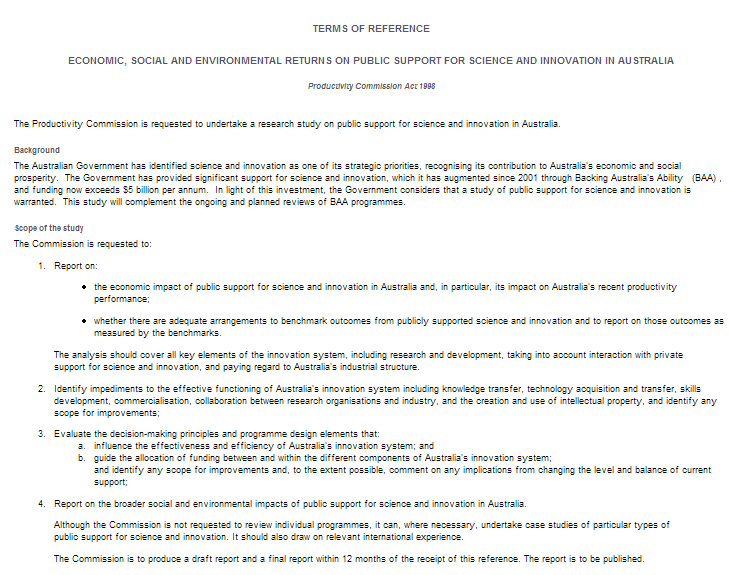
A month later a
twenty-six page issues paper![]() was released by the commission which noted the timetable and particulars on
making submissions
was released by the commission which noted the timetable and particulars on
making submissions
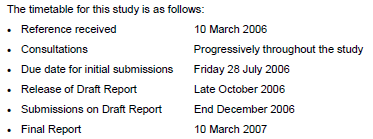
The issues paper makes the point, "Potentially this study is very broad in scope and participants are welcome to comment on any matters they consider relevant to the current terms of reference." But goes on to define for the purposes of its deliberations the terms Science, Innovation, Innovation system and R&D as well as Basic Research, Applied Research and Experimental Development.
What is of paramount interest are the interactions between research in all its facets, development and innovation and gauging those interactions is, to state the obvious, complex. Unfortunately, where mathematicians are prepared to worry a mathematical "conjecture" to the point where they are eventually able to prove or disprove its validity, more often than not political leaders will fasten on simple (linear) concepts of cause and effect in making decisions (even leaving aside any possible elements of immediate self-interest).
Indeed the issues paper warns, "it can be very difficult to find evidence of causal relationships between inputs (such as public funding) and outcomes (for example, productivity growth or higher incomes) in other than elementary ways (eg through simple correlations between increases in expenditure and productivity growth).
To date 86 initial submissions have been made to the Commission which range in size from a single page (Mr Colin Gourley) to 153 pages (CSIRO). Many are little more than hand-waving exercises but one stands out from the rest.
Professor Joshua Gans
(University of Melbourne) makes the points that "The economic argument for the
public support of science comes from recognising that science has the elements
of being a public good... it is non-rival in that it can be widely applied
without additional resource cost [and] it is partially excludable [,i.e.]
when someone makes use of science they can only appropriate a fraction of its
returns... This argument, however, does not inform us of the value of supporting
science relative to other economic activities and so is an incomplete case.
"[T]he case for the public support of
science comes from the quantitative impact this ultimately has on economic
growth. That impact comes through overall R&D expenditure by business. The
productivity of that expenditure is, however, driven by the functioning of
science as conducted in business as well as by government and within
universities."
And in his submission Professor Gans, who has developed
an econometric model* focuses on the linkage of scientific endeavour in the
universities, government research organisations and business.
Professor Gans also refers to a 575 page paper that is not a submission per se but is of major significance because it is a study paper written at the behest of the Productivity Commission. It was submitted to the Commission the month after the Treasurer and Ms Bishop directed the Commission to undertake its analysis into the "economic, social and environmental returns on public support for science and innovation in Australia"
Shanks, S. and Zheng, S. 2006, Econometric Modelling of R&D and Australia’s
Productivity, Productivity Commission Staff Working Paper, Canberra, April.![]()
The Concluding remarks by Shanks and Zheng?
The study has generated an array of empirical results that should contribute to furthering an understanding of the role that R&D has played, and continues to play, in the Australian economy.
However, the body of work in this study has also highlighted many challenges in the quantitative analysis of the effects of R&D on productivity. The paper presents the strengths and weaknesses (‘warts and all’) of different approaches. Quantitative analysis, carefully conducted and interpreted, can assist the assessment of the economic returns to investment in R&D in Australia. But it cannot supplant the need for judgment about what is adequately and reliably captured and what is not. This report presents an extensive information base to assist in the assessment of the returns from R&D investment and to contribute to a firmer foundation for future judgments.
At this point in time, there remains no precise, robust estimate of the effect of increases in domestic business R&D on Australia’s productivity performance. Standard models and estimation methods, grounded in theory, tended to generate unreliable results, as well as estimates that were sensitive to seemingly modest changes in specification. A comprehensive investigation of alternative specifications and estimation techniques brought new insights, but proved unable to arrive at any definitive estimate.
An economy in transition
The lack of robustness in the econometric modelling is partly due to fundamental measurement and analytical challenges. But it is also likely that sizeable ‘shocks’ to R&D and productivity in Australia over the past two decades have obscured, if not disrupted, the statistical relationship between them. Allowing for periods of adjustment to these shocks, there still may not be enough observations to determine any ‘new’ long-term relationship with precision.
While R&D-based theories emphasise a long-run structural relationship between R&D and productivity, it may be that the relationship is subject to such frequent shocks or random processes that there is no stable long-run or permanent effect. The average effect found in regressions is the average effect for the period under observation, which may not be a good measure of what the marginal effect would be from increasing R&D, say, over the next 10 years.
The question of course arises was the Federal Treasurer, was Ms Bishop aware of the assessment of Shanks and Zheng at the time of their direction to the Productivity Commission?
As Professor Gans Observes,
This conclusion is both surprising and troublesome for those who believe that public support for science and innovation should continue. This sort of result can lead to the following conclusion: perhaps we shouldn’t support R&D in Australia at all and instead get knowledge from the rest of the world. After all, the economy has travelled well without it for the last 14 or so years.
However, as I will argue here, it is an artefact of the particular exercise and data Shanks and Zheng were asked to work with. Correcting for that does yield a definitive estimate and I will report on those findings here.
The problem as professor Gans points out is that "Shanks and Zheng only use Australian data for their 575 page study. This means that their sample size is necessarily small (35 data points, one for each of 35 or so years)... The way growth economists have corrected for this issue has been to conduct multi-country analyses of the drivers of growth. This allows them to exploit more variation in the data across countries (e.g., allowing the experience of others to also inform on domestic effects) as well as to factor into account common macroeconomic shocks to growth across those countries. This permits more precise estimates and also allows us to isolate the Australian factor."
It will be interesting to follow the deliberations of the Productivity Commission as they release their draft report next month, the final report in March next year and then what the Government will do with it.
Below are several figures taken from the Australian Vice-Chancellors' Committee's submission which give a snapshot allowing national comparisons.
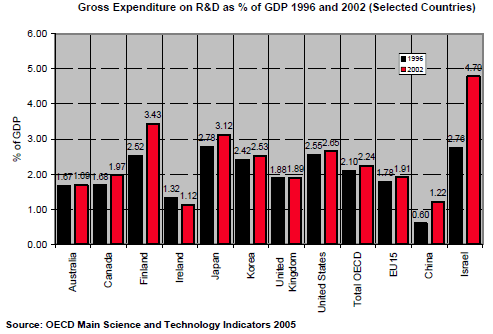
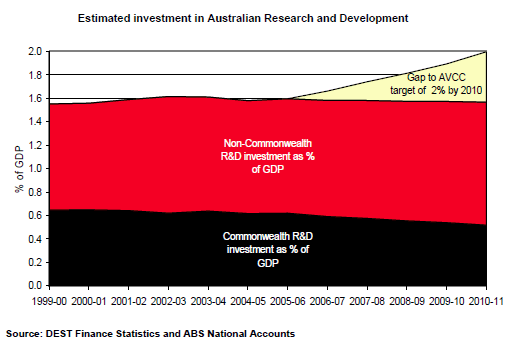
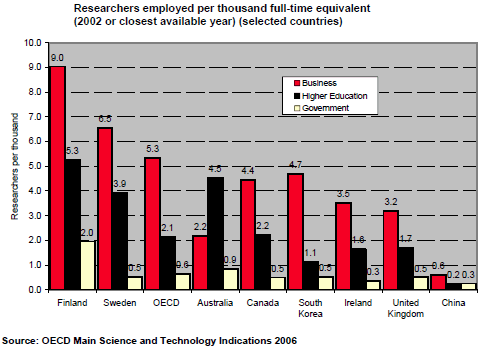

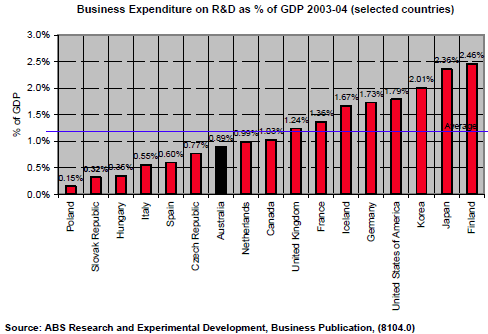
*Gans, J. & Stern, S. (2003). Assessing Australia’s innovative capacity in the 21st Century. IPRIA Report. www.mbs.edu/home/jgans/papers/Innovation Index Australia.pdf
Gans, J. & Hayes, R. (2004). Assessing Australia’s innovative capacity: 2004 update. IPRIA Report 03/04. www.mbs.edu/home/jgans/papers/Innovation%20Index-2004%20Update.pdf
Gans, J. & Hayes, R. (2006). Assessing Australia’s innovative capacity: 2005 update. IPRIA Report 02/06. www.ipria.org/publications/Reports/AUs%20Innovation%20Index%202006.pdf
Alex Reisner
The Funneled Web